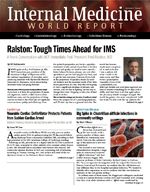Steroid Prednisolone Effective In Diagnosis of COPD
Steroid Prednisolone Effective In Diagnosis of COPD
Diagnosing chronic obstructive pulmonary disease (COPD) and differentiating it from asthma can be difficult in primary care settings. One suggested method uses spirometry in combination with prednisolone.
“A diagnosis of COPD or asthma is based on a combination of signs, symptoms, and (repeated) spirometry results which leaves room for interpretation”, said Berna D.L. Broekhuizen, MD, from the University Medical Center Utrecht in the Netherlands. “The overlap between asthma and COPD has been extensively discussed in the past, and especially in elderly, this can complicate a straightforward diagnosis.”
The group enrolled 233 patients, 98 of whom had a cough lasting longer than 14 days with no known COPD or asthma who consulted their Dutch primary care providers between 2006 and 2009. Patients were given a 14-day test using prednisolone 30 mg/d. Before and after the prednisolone test, post-bronchodilator measurements of forced air expiratory volume in 1 second (FEV1) were obtained. An expert panel determined the presence or absence of COPD or asthma based on an extensive diagnostic work up. The proportion of those who had increased FEV1 exceeding 200 ml or 12% of baseline per diagnosis group was compared. The diagnostic value was quantified using logistic regression and an analysis of the area under receiver operating characteristic curve (ROC area).
“Physicians have often used, and still may be using, this oral steroid test in their daily practice work up for COPD or asthma,” said Dr. Broekhuizen. “The thought that spirometry results in COPD are much less variable than in asthma was the reason to assume that repeating spirometry after a test with oral corticosteroids might be useful in diagnosing chronic lung problems. Since there are no studies reporting the diagnostic value of prednisolone in patients, the truth of this assumption was unclear.”
In patients with COPD, 23% (14 of 61) responded to the test. The response rate in asthma was 4% (1 of 25) and 7% in those with both asthma and COPD. Among patients with no diagnosis for either illness, 11% (14 of 133) responded according the criteria. Being a responder was associated with COPD (Odds ratio [OR]= 2.4; 95% confidence interval [CI], 1.1-5.2). A multivariate analysis, adjusting for age, sex, and smoking resulted in an OR = 2.0 (95% CI, 0.8 to 5.0) and the area under the ROC curve did not increase (0.78; 95% CI, 0.72-0.85 vs. 0.79; 95% CI, 0.72 to 0.85).
“Being a responder to the test treatment was suggestive of COPD, contrary to earlier assumptions,” said Dr. Broekhuizen. “However, there was no clear value for diagnosis or exclusion in addition to other, more easily obtainable information. Moreover, many patients have objections against using oral steroids as a test. Because of this we do not recommend this test when COPD is suspected.”
The Netherlands Organization for Health Research and Development and grants from GlaxoSmithKline, Boehringer-Ingelheim, and Pfizer funded the study. One or more of the authors have been speakers at congresses sponsored by pharmaceutical companies.
Source: Broekhuizen BDL, et al. Diagnostic value of oral prednisolone test for chronic obstructive pulmonary disorders. Ann Fam Med. 2011;9:104-109.
